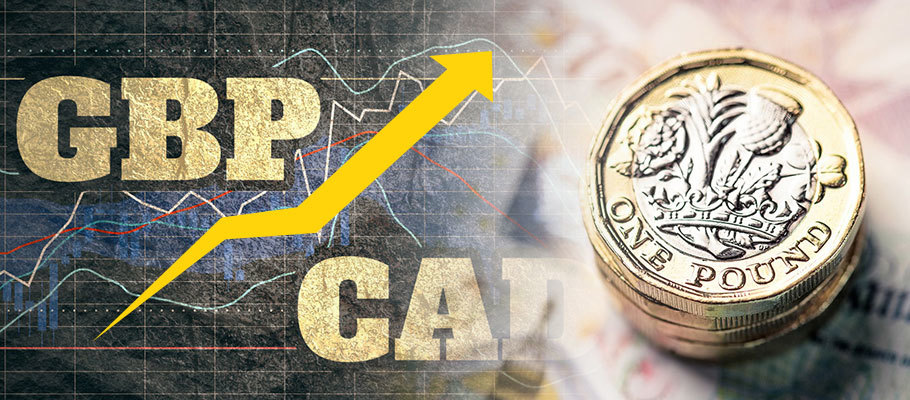
Published: August 23rd, 2021
The Pound-to-Canadian Dollar rate finished last week on multi-month highs as the loonie was hammered by risk-averse global markets and the latest signals on policy action from the US Federal Reserve (Fed). The risk of correction was rising at week’s end, though it didn’t materialise before Friday’s close.
Both CAD and GBP were sold heavily against the greenback through much of last week, but loonie losses were far worse, culminating in a USD/CAD rally that pulled CAD below to 2021 lows while pushing GBP/CAD sharply up.
The resurgent greenback rose after the minutes from July’s Fed meeting were published on Thursday, putting America’s fighting fiat back onto the front foot.
FX strategists at BMO Capital Markets to the Toronto Globe and Mail that the minutes from the Fed meeting ‘sparked a mild taper tantrum’ in forex markets.
‘The USD rally has been energised by a combination of risk-off and Fed-on. While aggregate long-USD positions this week haven’t spiked, we think it is important to note that the currency market is already long-USD.
‘Against that backdrop, we believe a point has been reached where long dollar bets might start to wane. The risk is that Fed Chairman Powell will use the upcoming Jackson Hole meeting next week to update the minutes and indicate a different direction.’
The minutes from the Federal Open Market Committee’s (FOPMC) July 28th meeting showed members were of the view that if US economic growth meets the Fed’s June’s projections, the conditions will have been met for winding down the USD 120 billion-per-month quantitative easing programme before the 3end of 2021.
The change in consensus came as a surprise to a significant number of analysts and market commentators, and evidently forex traders too, given how consistent expectations have been that the world’s leading central bank would announce something in October or November, with a view to scaling back the QE programme at some stage in the new year.
On the news, the greenback strengthened across the board, even nudging the leading pound/dollar pair to a 2021 loss. The loonie also suffered in the CAD/USD pair, leading the US dollar to become, for the time being at least, the best performer on the G10 list of major currencies for the year-to-date.
Scotiabank’s FX Strategy unit wrote in a note to investors that the week’s Canadian CPI numbers release ‘surprised markets in terms of the upside’, both in headline and core figures.
However, the Canadian dollar barely reacted as the Bank of Canada recently said that high price gains are expected to be temporary. The central bank will likely stay on track as it winds down its own QE programme in December. ‘Markets will soon start to position themselves more clearly ahead of the bank’s scheduled policy update on September 8th,’ they wrote.
Last week’s price action came after Canadian inflation returned with a vengeance in July after a benign set of consumer price index numbers for June. Those raised the Bank of Canada’s three inflation measures to 2.44 per cent, which is above the BoC’s target.
The negative price action for CAD also happened before the release of July retail sales figures for both the UK and Canada, with both economies expected to see a strong rebound from earlier economic closures. Analysts were projecting that positive signals could potentially put a floor under the Canadian dollar, potentially setting up a pre-weekend correction lower for GBP/CAD.
In the end it that uplift didn’t materialise. At Friday's close, the Canadian dollar was scraping the bottom of the major currency barrel and on course for its worst week of returns since March 2020. Markets turned gloomy as risk-averse traders ignored the data, which clearly indicated a robust, if still pending, recovery for Canada's economy.
As anticipated, data from Statistics Canada showed Canadian retail sales up by a healthy 4.1 per cent at the end of the second quarter. That was slightly less than the 4.3 per cent expected by economist consensus. However, core retail sales grew by 4.6 per cent, which was slightly ahead of the 4.5 per cent markets were anticipating.
The core measure of retail revenue doesn’t include sales of big-ticket items like cars and ignores gasoline sales. Their size and price volatility, respectively, can distort the figures, so statisticians don’t include them.
The rise in sales came after several Canadian provinces gave the green light to non-essential businesses to end lockdown restrictions, following a reduction in the latest wave of coronavirus infections. Statistics Canada’s advance estimates for July actually suggested that sales had slipped by -1.6 per cent in the previous month.
The good news wasn’t enough to stop the loonie’s slide, however. CAD edged lower after the data release, continuing its week of underperformance and putting it near the bottom of the major currency barrel for the week overall.
Commodity currencies like the loonie, New Zealand (NZD) and Australian dollars (AUD) were all casualties of the rally in USD last week.
Why did it happen? Expectations for recovery in global demand are starting to cool. CIBC’s head of forex strategy told Bloomberg that the gloomier view could be caused by the rise in Delta variant cases and the restrictions that tend to follow, ‘but it’s getting harder to ignore that sentiment in global markets has soured in recent weeks.’
Worries about the global economic picture have been a regular feature in analyst commentary this week. There have been indications that critical sectors of European economies are weakening, while APAC economies are being besieged by COVID-19 again and the lockdowns used to fight it. Even New Zealand, which has arguably had the best COIVID-response since the outbreak began, has recently seen an upsurge in cases.